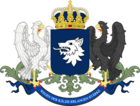History of Tyrnica
This article is incomplete because it is pending further input from participants, or it is a work-in-progress by one author. Please comment on this article's talk page to share your input, comments and questions. Note: To contribute to this article, you may need to seek help from the author(s) of this page. |
Part of a series on the |
|---|
| History of Tyrnica |
 |
Early Middle Ages (987–1200)
Late Middle Ages (1200–1479)
Monarchs of the Late Middle Ages
- House of Sigismund
- Sigismund I the Old, 1200–1219
- House of Dragney
- Audun IV, 1219–1232
- Audun V, 1232–1238
- House of Sigismund (continued)
- Sigismund I the Old, 1238–1244
- Henrietta V, 1244–1260
- House of Lanstadt
- Ulrich VI, 1260–1273
- Erich III, 1273–1299
- Ulrich VII, 1299–1317
- Erich IV, 1317–1348
- Ulrich VIII, 1348–1363
- Erich V, 1363–1372
- Helga I, 1372–1386
- Charles I, 1386–1404
- Charles II, 1404–1423
- Caroline I, 1423–1424
- House of Arcions (disputed 1423–1477)
- Charles III (1423–1443)
- Rosalie I (1443–1468)
- Louis VII (1468–1477)
- House of Audun
- Audun VI, 1426–1436
- House of Charlotte
- Charlotte I, 1444–1449
- House of Elise
- Elise I, 1449–1456
- Erich VI, 1456–1460
- House of Varberg
- Frederick I (1460–1474)
- Frederick II (1474–1504)
Fifty Years' War (1423–1477)
Charles II died unexpectedly in 1423, leaving his infant daughter Caroline as his only living offspring. Although the Rechtzuhör tentatively confirmed Caroline as queen, the succession was disputed by several of her relatives. Ludwig, the brother of the late Charles II, had been under the impression that he would be treated as the heir until Caroline reached the age of majority. Historical records appear to reinforce his claim, and it is still not known what factors motivated the court to favour the infant Caroline instead. As the Margrave of Schwarzeberg, he would also have been entitled to make his views heard in the Rechtzuhör, but in 1422 had moved to the aid of the Order of Saint Perende against Ornish incursions. Ludwig was reluctant to press his claim by force, since he would have had to abandon his defense of Elstock and might have been branded a fey-forrader (lit. coward-traitor).
The most prominent challenge to Caroline's rule came from the Blaykish monarch, Arthur of Arcions.[1] Arthur was a first cousin of Caroline (a nephew of Charles I), and began to style himself as Charles III. It was not uncommon for Blayk and Tyrnica to conduct relations in this way (the Blaykish flag still features three crowns), but it was rare for such claims to result in actual conflict. It was considered especially unlikely for Charles III to press his claim so soon after emerging victorious in the Fourth War of the Eagles, which had already shifted the balance of power in the Occident decidedly towards Blayk. Some sources believe that Charles may have wanted to control both sides of the Strait of Khovaar. Charles had taken large loans from the Galene Sea trading leagues that operated in Karsfjord, Avilême, and Sarbéliard during the Fourth War of the Eagles. Stifling maritime trade through the Strait could have provided Charles with leverage to avoid repaying the debts that had financed the war. Another common legend is that Charles wanted to carve out a new empire in Northern Auressia without connections to the Sabarine legacy that had characterised Blayk's conflict with Orlesso. Although the concept has little historical basis, it is a popular origin myth of the Commonwealth and has commensurately become more widespread in the 20th and 21st centuries.
The aged Konrad von Felsen had been a well-known hvissvaye ("open lover") of Helga I, and in spite of his age commanded a deal of respect in the court. He emerged as the most prestigious member of Charles II's chancellery and was approved as Caroline's regent by the Queen Dowager Mira soon after her husband's death. However, Caroline had been born premature, and physicians had thought her survival to be unlikely. She died in 1424, when she was around eighteen months old. Although her death had been predictable, it threw the court into disarray. Konrad von Felsen proved unable to motivate the Rechtzuhör to select an heir.
Early Modern Period (1477–1783)
Monarchs of the Early Modern Period
- House of Varberg
- Frederick II, 1474–1504
- William III, 1504–1522
- Ulrich IX, 1522–1573
- Erich VII, 1573–1602
- Ulrich X, 1602–1617
- Nicholas I, 1617–1625
- William IV, 1625–1642
- William V, 1642–1693
- William VI, 1693–1709
- House of Varberg-Laubbachen
- Hedwig I, 1709–1723
- Leopold I, 1723–1745
- Audun VII, 1745–1770
- Leopold II, 1770–1783
Varberg golden age (1477–1573)
Colonisation and expansion (1573–1642)
Centralisation (1642–1748)
Eleven Years' War and aftermath (1748–1783)
- ↑ Arthur is almost always referred to as Charles III, even though he was the first monarch by that name in Blayk and was never recognised as a legitimate ruler of Tyrnica.